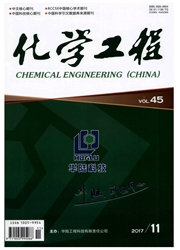

 中文摘要:
中文摘要:
为寻求涡流空气分级机进口风速和转笼转速的最佳匹配,利用Fluent软件对涡流空气分级机内部流场进行模拟分析,得出:当进口风速与转笼外缘的切向线速度相等或相近时流场最稳定。在流场较稳定的前提下,较高进口风速和转笼转速时,环形区湍流耗散率更大,更有利于物料的分散及分级。碳酸钙物料实验表明:转笼转速分别为800 r/min和1200 r/min时,取进口风速分别为9m/s和12m/s,分级精度和牛顿分级效率都较高。其中进口风速为12m/s,转笼转速为1200 r/min时,分级精度和牛顿分级效率最优。该结论为利用涡流空气分级机进行分级合理调节进口风速和转笼转速提供理论依据。
 英文摘要:
英文摘要:
The inner flow field of turbo air classifier under different operations was simulated by Fluent software in order to find out the best match of air inlet velocity and rotor cage's rotating speed of a turbo air classifier. The simulation results show that the flow field is stable when the air inlet velocity is close to the tangential linear velocity on the outer diameter of the rotor cage. Under the stable flow field, when air inlet velocity and rotor cage's rotating speed are high, the air turbulent dissipation rate is high, which is benefit to the dispersion and classification of powders. Calcium carbonate powders experiments show that when rotating speed is 800 and 1 200 r/min, respectively, setting air inlet velocity as 9 m/s and 12 m/s, respectively, and the accuracy and the Newton classification efficiency of the turbo air classifier are high. And when the air inlet velocity is 12 in/s, and the rotor cage's rotating speed is 1 200 r/min, the accuracy and the Newton classification efficiency of turbo air classifier are the highest. This provides theoretical basis to adjust the air inlet velocity and rotor cage's rotating speed suitably for turbo air classifier.
 同期刊论文项目
同期刊论文项目
 同项目期刊论文
同项目期刊论文
 Classification performance comprehensive evaluation of an air classifier based on fuzzy analytic hie
Classification performance comprehensive evaluation of an air classifier based on fuzzy analytic hie Studies on Classification Performance Assessment of a Dry Classifier Based on Analytical Hierarchy P
Studies on Classification Performance Assessment of a Dry Classifier Based on Analytical Hierarchy P 期刊信息
期刊信息
